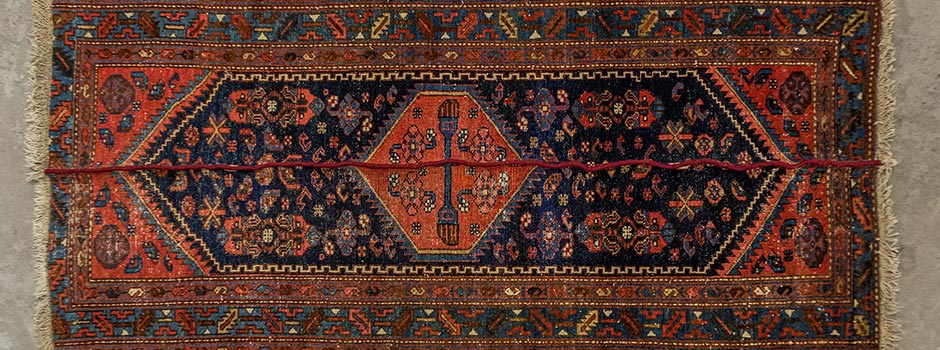
GREEN ART GALLERY AT LISTE, ART FAIR BASEL (JUNE 16-21, 2015) A Solo Project by Emerging Iranian Artist Nazgol Ansarinia
Jun 21, 2015 Exhibition

 Liste 2015, Nazgol Ansarinia, installation-view / Courtesy of Green Art Gallery and the Artist
Liste 2015, Nazgol Ansarinia, installation-view / Courtesy of Green Art Gallery and the Artist
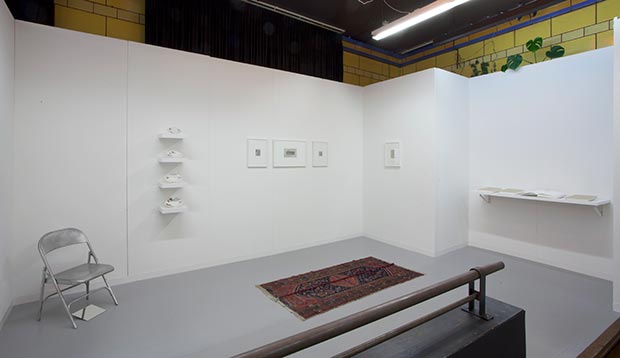 Liste 2015, Nazgol Ansarinia, installation-view / Courtesy of Green Art Gallery and the Artist
Liste 2015, Nazgol Ansarinia, installation-view / Courtesy of Green Art Gallery and the Artist
Private Assortment addresses the generalised sense of anxiety endemic to a city like Tehran. In Folding Chair (2013), a stash of artifacts (personal identification documents, a CD-ROM, a mobile phone) has been pinned to the undercarriage of an otherwise rather ordinary folding chair. Everything you might need for a quick getaway, nestled into purpose-made recesses and camouflaged in tones of grey. Thus hidden from the prying eyes of the State, the hoard is revealed to the viewer only by their reflection in a mirror placed on the floor under the chair. Notably, none of these objects appear painted. Rather, in their chameleon-like blending with their host furniture, they hint of several other such private assortments. Invoking the curiously dense weight of surveillance, the acute claustrophobia of urban living, the safe anonymity of encryption services and VPN, and the precarity of contemporary life, Private Assortment speaks to deeply felt tensions which are ultimately applicable to any country, any city.
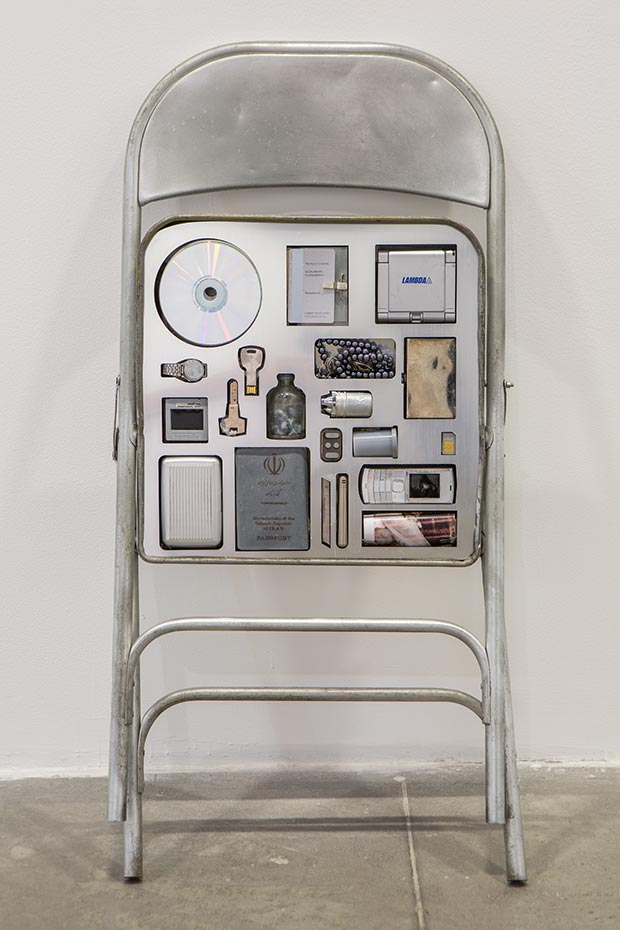 Nazgol Ansarinia, Private Assortment Series, 2011-2013, Metal Chair, 2013, mixed media, 50 x 46 x 80 cm / Courtesy of Green Art Gallery and the Artist
Nazgol Ansarinia, Private Assortment Series, 2011-2013, Metal Chair, 2013, mixed media, 50 x 46 x 80 cm / Courtesy of Green Art Gallery and the Artist
Reflections/Refractions explores the complexities involved in reflecting upon the everyday. Newspapers are a particularly contested site of depicting the prosaic; here, the artist conscripts Iran’s oldest newspaper Ettelaat—the name literally translates as ‘information’—to underwrite the series. Each piece incorporates the geometric grid of mirror mosaics to tesselate together shards of a single news item drawn from two different publications on the same date. The doubled titles in themselves speak quiet volumes about the subjectivity of objective journalism.
Geometric designs, often used to evoke beauty in their order and symmetry, take on very different qualities when applied to mirror work. The very precision and care that goes into the crafting mirror mosaics work to fracture, displace, and distort the reality of anything they reflect. They claim no intention of staying true to their subjects, amplifying some parts even as they willfully obscure others. As a familiar element of Iranian visual culture, they become an apt metaphor for both news media and the construction of reality. Following Marshall McLuhan, newspapers are largely understood to be ‘hot’ media, delivering information to be passively, unquestioningly consumed. Yet Reflections/Refractions shows that what one perceives to be the true reflection of an event ultimately turns upon having access to a variety of sources and actively reconstructing a whole from fragments of information.
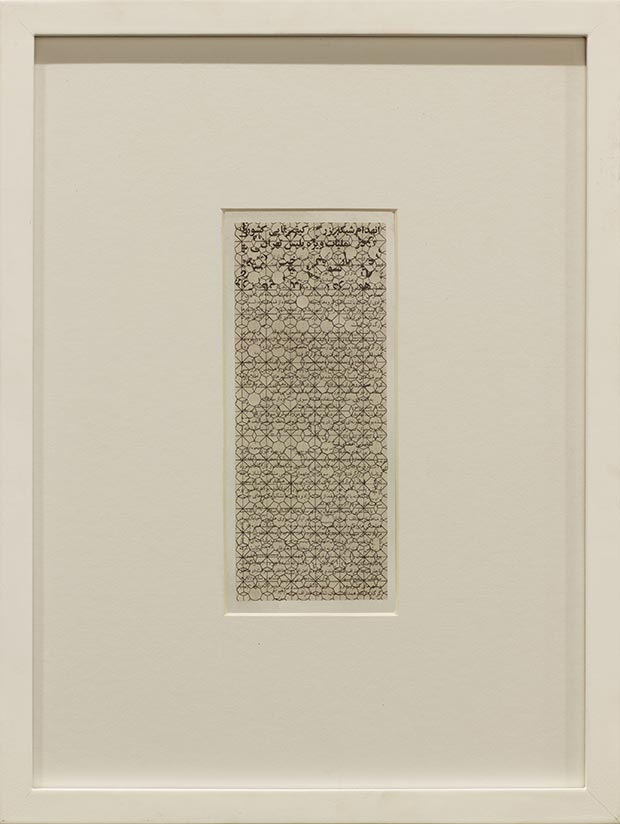 Nazgol Ansarinia, Reflections/Refractions, 2012, Special Police Operation in Tehran Destroys a Network of Bag Snatchers. Metropolitan Police Destroys a Network of Bag Snatchers, newspaper collage, framed 30 x 40 cm / Courtesy of Green Art Gallery and the Artist
Nazgol Ansarinia, Reflections/Refractions, 2012, Special Police Operation in Tehran Destroys a Network of Bag Snatchers. Metropolitan Police Destroys a Network of Bag Snatchers, newspaper collage, framed 30 x 40 cm / Courtesy of Green Art Gallery and the Artist
 Nazgol Ansarinia, Reflections/Refractions, Announcement of Tehrans Elections Results Not Known Yet. Latest results from Counting of 2146 ballot boxes in Tehran, 2012, newspaper collage, 40 x 30 cm / Courtesy of Green Art Gallery and the Artist
Nazgol Ansarinia, Reflections/Refractions, Announcement of Tehrans Elections Results Not Known Yet. Latest results from Counting of 2146 ballot boxes in Tehran, 2012, newspaper collage, 40 x 30 cm / Courtesy of Green Art Gallery and the Artist
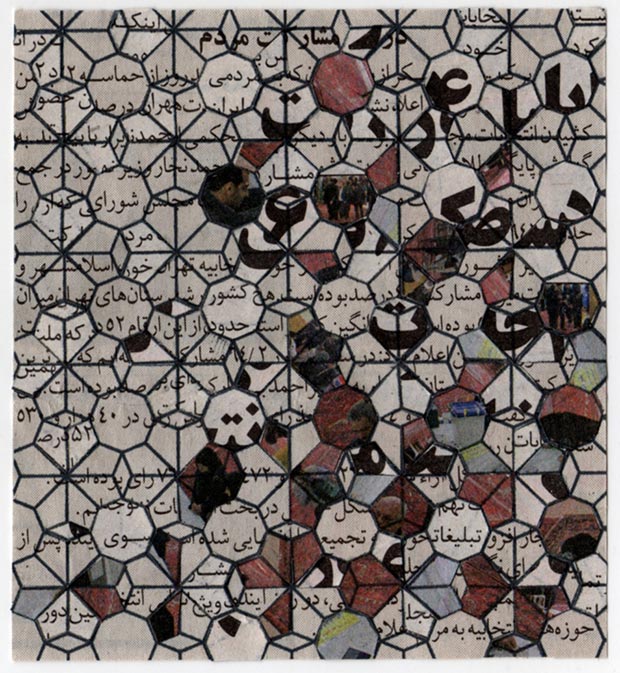 Nazgol Ansarinia, Reflections/Refractions, Peoples Participation Rate. 64% Participation in Elections, 2012, newspaper collage, 40 x 30 cm.jpg / Courtesy of Green Art Gallery and the Artist
Nazgol Ansarinia, Reflections/Refractions, Peoples Participation Rate. 64% Participation in Elections, 2012, newspaper collage, 40 x 30 cm.jpg / Courtesy of Green Art Gallery and the Artist
 Nazgol Ansarinia, Reflections/Refractions, Storage of essential goods during the last days of the year. Distribution of stored fruits from March 10th, 2012, newspaper collage, 40 x 60 cm / Courtesy of Green Art Gallery and the Artist
Nazgol Ansarinia, Reflections/Refractions, Storage of essential goods during the last days of the year. Distribution of stored fruits from March 10th, 2012, newspaper collage, 40 x 60 cm / Courtesy of Green Art Gallery and the Artist
In Mendings, ordinary household objects show scars of an inwardly-held trauma. The series includes a selection of furnishings—mattresses, chairs, carpets, mirrors—which have been bisected and then reassembled with a visibly sutured fault line. They have been reconstructed in a way that retains their balance, symmetry and functionality despite their missing sections. Even as they retain a discernible semblance of their former selves, viewing these new objects is an uncomfortable experience. The objects are wood and metal and fabric and glass, yet manage to induce the same visceral queasiness as a scalpel taken to flesh. Irrevocably mutated in their mending, the new forms are made fragile, uneasy, and unsettling.
_2010_Mixed-media_195x95cm_01.jpg) Nazgol Ansarinia, Mendings (carpet), 2010, Mixed media, 195 x 95 cm / Courtesy of Green Art Gallery and the Artist
Nazgol Ansarinia, Mendings (carpet), 2010, Mixed media, 195 x 95 cm / Courtesy of Green Art Gallery and the Artist
_2010_Mixed-media_195x95cm_02.jpg) Nazgol Ansarinia, Mendings (carpet), 2010, Mixed media, 195 x 95 cm / Courtesy of Green Art Gallery and the Artist
Nazgol Ansarinia, Mendings (carpet), 2010, Mixed media, 195 x 95 cm / Courtesy of Green Art Gallery and the Artist
_2012_china-plates_glue, size-variable.jpg) Nazgol Ansarinia, Mendings (plate), 2012, china plates, glue, size variable / Courtesy of Green Art Gallery and the Artist
Nazgol Ansarinia, Mendings (plate), 2012, china plates, glue, size variable / Courtesy of Green Art Gallery and the Artist
As an international graduate student in the US post-9/11, the artist found herself suddenly subject to newly implemented national security policies. In order to take control of this development she started to create works experimenting with related materials, focusing on one particular document known as the NSS report. As she investigated new modes of engaging with the report’s content, the artist became increasingly aware of the language that was being used. By making a lexicon dictionary as a companion piece to the report itself, she noticed that an alphabetized lexicon in itself—including any redundant entries—revealed some very interesting relationships. Through this reading of the report, one begins to question the repetition and the emphasis on certain words, or the unexpected appearance of others. Breaking the syntactical relationships between the words also caused some curious juxtapositions, in effect giving rise to new and entirely unexpected meanings.
Years later, these ‘National Strategy’ documents and the language they have produced seem to be playing an increasingly more pronounced role in shaping the events related to the countries it mentions. The NSS Book Series is an extended version of the visual-linguistic experiment the artist initially began in 2001. It focuses on four of the most recent documents in the series; three of which feature the word ‘Iran.’
NAZGOL ANSARINIA b. 1979, Tehran. Lives and works in Tehran.
GREEN ART GALLERY is based in Dubai, UAE. Its program features multigenerational mix of contemporary artists from the Middle East, South Asia and beyond, working across different media. Other represented artists include Shadi Habib Allah (PS), Kamrooz Aram (IR/US), Alessandro Balteo Yazbeck (VE), Zsolt Bodoni (HU), Hera Büyüktaşçıyan (TR), Seher Shah (PK), Hale Tenger (TR), and Nazif Topçuoğlou (TR).
Comments
Add a comment